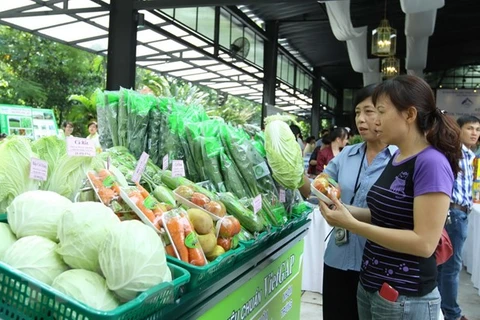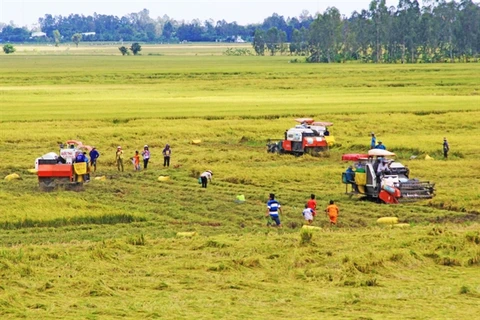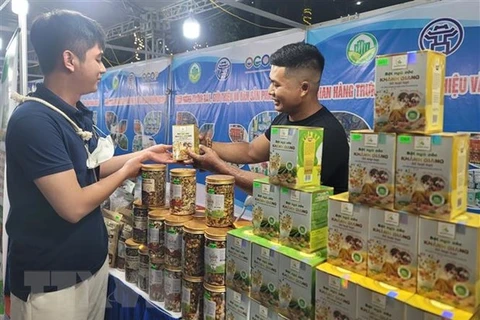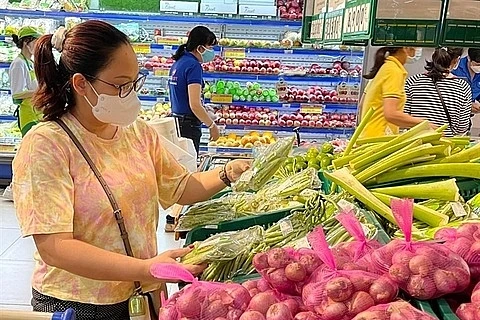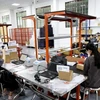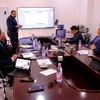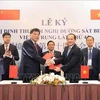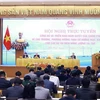 The Women's Union of Phu Quy district presents eco-friendly biodegradable plastic bags to sellers at Tam Thanh Market, Phu Quy island, the southern province of Binh Thuan. (Photo: VNA)
The Women's Union of Phu Quy district presents eco-friendly biodegradable plastic bags to sellers at Tam Thanh Market, Phu Quy island, the southern province of Binh Thuan. (Photo: VNA) The June 28 event titled "Vietnam Consumer Trends Forum 2023: Trends and Retail Market", was held by the Institute for Brand and Competitiveness Strategy (BCSI).
Important factors when consumers choose a brand were reasonable price, safety and hygiene, good for health, reliable brand, sustainability and eco-friendliness, said Ha.
55% of consumers surveyed by NielsenIQ Vietnam in 2023 appreciate the sustainability factor in consumption.
As proof, Hà said that 49% of consumers brought their own bags or use recycled bags when shopping.
47% only buy essentials and avoid waste. 45% are conscious of saving electricity at home and 45% sorting recyclable waste.
Specifically assessing from separate research on consumers in Hanoi and HCM City, Trinh Nguyen Ngoc Linh, Senior Manager of Intage Vietnam Project, said that 95% of consumers in these two big cities have an awareness of environmental protection.
59% of consumers choose to eat green vegetables and grains more often.
61% prioritise making use of natural light as much as possible, 44% reuse old clothes instead of buying new ones unnecessarily.
This study also shows that consumer segments are aware of green consumption, in which 24% said living green to save, 22% green consumption to focus on health; and 9% accompanied the trend.
Do Van Viet, representative of the Vietnam E-commerce Association (Vecom), said that more and more consumers choose e-commerce as a regular shopping channel because of its multi-faceted convenience.
Currently, e-commerce in Vietnam is developing rapidly with a double-digit growth rate per year.
More and more businesses and sellers are turning to e-commerce to reach consumers, especially on channels such as social networks and artificial intelligence.
Citing the example of Bac Giang provincial Youth Union selling lychees on TikTok Shop Vietnam, Viet said that many live stream sales sessions in just a few hours could sell tonnes of lychee with thousands of orders.
"Businesses need to grasp trends, have solutions to access e-commerce channels and need to deploy multi-channels to create many touch points with customers," he recommended.
Emphasising digital transformation solutions to bring agricultural products closer to consumers, especially young consumers, Dr. Vo Tri Thanh, Director of the Institute for Brand and Competitiveness Strategy (BCSI), said that the leading role was a very important need in the transformation; at the same time, digital transformation needed to be tied to the real world, the real strategy of the business could be successful.
In addition, thanks to the "online shop" developed in the digital environment such as Tik Tok, Facebook, thousands of households making agricultural products from mountainous areas such as Lang Son and Lao Cai provinces have sold hundreds of orders just through “livestreams”.
“Thanks to the new business models that digital transformation brings, there are aspects of business that can caught up. Although it may be expensive in the medium term, in the long term, digital transformation brings great economic benefits to the Vietnamese retail market,” said Thanh.
Suggesting for manufacturing and retail businesses, Đặng Thúy Hà, northern director of NielsenIQ Vietnam, offers short, medium and long-term solutions.
That was developing a new retail model associated with green product experience, establishing clubs for sustainable consumers, awarding points for buying sustainable products, she added.
She also suggested businesses replace or reduce plastic in packaging; develop carbon-neutral factories and farms; use electric vehicles, and develop regenerative agriculture.
At the event, Nguyen Minh Tien, Director of the Trade Promotion Centre for Agriculture under the Ministry of Agriculture and Rural Development, shared, recently, the trend of safe food of natural origin and environmental friendliness has become popular and become a modern consumption. This is an inevitable trend not only in Vietnam but all over the world.
Facing the trend of consuming safe products, especially organic products with sales in Vietnam reaching 208 billion USD last year, Tien recommended solutions in which authorities need to control the quality of agricultural products on the market, improve the effectiveness of consumer protection; promote information and communications so that clean producers can see the value of standard production, and consumers understand the value of clean agricultural products; especially need to improve agricultural production capacity to meet market demand./.
VNA
